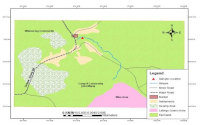The Effect of Heavy Metal Pollution on Some Haematological Parameters in Domestic Birds: A Study in Camp2 Village, Akamkpa Local Government Area of Cross River State, Nigeria
Main Article Content
Abstract
This study was conducted to evaluate the concentrations of heavy metals in the blood of birds reared for food in Camp2 Community of Akamkpa, Cross River State, Nigeria. Twelve (12) male indigenous jungle fowls (Gallus domestica), six each from the control site (Ugep) and from Camp2 were sampled for the studies. Venous blood samples from the wings of the blood were collected and used for hematological and metal analysis. After digestion of the blood, heavy metals [cadmium (Cd), Lead (Pb), Mercury (Hg), Chromium (Cr), Arsenic (As), and Nickel (Ni)] were detected using atomic absorption spectrophotometer (AAS). The results indicated that Cd, Pb, As and Hg) levels in birds from camp2 village was significantly higher (p<0.05; p = 0.0070) than those of the Ugep control site. The average value of nickel in the blood of Camp2 birds (4.72+1.32mg/L) was significantly higher (p>0.05; p= 0.003) than that of the Ugep control site (4.22+1.07mg/L). The result shows that nickel, lead and Cadmium in blood samples were significantly (p<0.05; p = 0.023) higher in Camp2 compared to the control site. Hence, these values were above WHO standard (0.1mg/l) and FAO/WHO standards of (0.2mg/kg) while others were within joint FAO/WHO standard limit. The studies show that domestic birds can bioaccumulate heavy metals in their blood, which in turn, presents serious health risks to humans who consume these birds within the communities.
Downloads
Article Details

This work is licensed under a Creative Commons Attribution-NonCommercial-NoDerivatives 4.0 International License.
References
Afullo, O.A. and Odhiambo, F. (2009). The primary social waste storage gaps experienced by Nairobi household. Ethiopian Journal of Environmental Studies and Management, 3: 34-42.
Agency for Toxic Substance and Disease Registry (ATSDR). (2007). Toxicological for lead. Atlanta Georgia, United States.
US. Department of Health and Human Services. Pp 3-5.
Beyersmann, D. (2002). Effect of Carcinogenic metals on gene expression. Toxicology Letters, 127: 63-68.
Barltop, D. and Smith, A. (1971). Inter-action of lead with erythrocytes. Journal of Experimental Biology, 27:92.
Burger, J., (1993). Metals in avian feathers bioindicators of environmental pollution.Rev. Environ.Contam. Toxicol., 5:203-
Chakarabarti, S.K., Bai, C. and Subramanian,K.S. (2001). DNA-protein cross links induced by mickel compounds in isolated rat hymphoeyles role of reactive oxygen species and specific amino acids. Toxicological and Applied Pharmacology, 170(3): 153-165
Deknudt, G. (1977). Chromosomal aberrations in workers professionally exposed to lead. Journal of Environmental Toxicology and Health, 3:885.
Dudka, K. and Miller, W. P. (1999). Accumulation of potential toxic elements in plants and their transfer to human food chain. Journal of Environmental Science, 34(4): 6851-708.
Harman, D. (1981). The aging process.Proceedings of the National Academic of Science, 78 (11): 7124- 7128.
Hartwig, A., and Schwerdtle T. (2002). Interactions by Carcinogenic metals compound with DNA repairs process: Toxicological implications. Toxicology Letters 127:47-54. Doi:10.1016/s0378- 4274
Karmaka, R., Bhahacttarya, R., and Chatterjee, M (2007). Biochemical Haematological and histopathological study in relation to time-related Cadmium-induced hepatotoxicity in mice. Biometals: 13, 231-239.
Kasprzak, KS., Sunderman FW., and Vr, Salnikowk. (2003). Nickel Carcinogenesis. Mutation Research.533:67-97.
Kimanic, N.G. (2007). Implications of the Dandora municipal Dumping site in Nairobi, Kenya. Environmental Pollution and Impacts of public health, Kenya, United Nations Environment Programme.
Latuente, A, Gonzatez-Carvaledo., A Romero., A, and Esquitino A.I (2003). Effect of Cadmium on lymphocyte subsets
distributions in thymus and spleen. Journal of Physiological Biochemistry, 59: 43-48.
Lisk, D.J. (1998). Environmental implication of incarceration of municipal solid waste and ash disposal. The Science of the Total Environment, 74: 39-66.
Mboso, O. E., Odey, M. O., Uboh, F. E., Essien, N. M., Chidinma, O. and Eyong, E. U. (2014) Erythropoietic effects of
Eremomastax polysperma leaf extracts on female prepubertal and pubertal wistar rats. British Journal of Pharmaceutical Research, 4 (15): 1833- 1839.
Melville, G.J. and Welsh, A.H. (2001). Line transect sampling in small regions. Biometrics, 57: 1130-1137.
Sembulingam, K. and Sembulingam, P. (2002). Essentials of medicals physiology (2nd Ed.), New Delhi: Jaypee Brothers
Medical Publishers. 277 – 332.
Silbergeld, E.K. (2003). Facilitative mechanisms of lead as a carcinogen. Mutation Research, 533;121-133
Stanley, L., Helen, K.H and H.H. (2005). Clinical laboratory tests, values and implications. (3rd Ed) Pennsylvania: Springhouse Press. Pp 61 – 98.
Svoboda, M., Kouril, J., Hamakova, J., Kalab, P., Savina, L., Svobodova, Z. and Vykusova, B (2001). Biochemical profile
of blood plasma of tench (Tinca tinca L.) during pre- and post-spawning period. 70, Acta Veterinaria Brno, 3: 15 – 24
UN-Habitat. (2008). The state of African cities. A frame work as addressing urban challenges in Africa. United Nation
Human Settlement Programme. Pp. 23 USEPA. (2002). Solid and Emergency Response. In Agency, USEPA. http://www.epa.gov/tech. Retrieved May which date? 2016.
USEPA. (2007). Toxicity exposure assessment of children’s health. Marganes TEACH Chemical Summary. http://www.epa.gov/tech. Retrieved August, 2013.
Uwah, E.I., Ndahi, N.P., Abdularahman, F.I. and Ogugbuaja, V.O. (2011). Heavy metal eads in spinach
Amarathuscaudatus) and lettuce (Cactuca sativa) grown in Maiduguri, Nigeria. Journal of Environmental Chemistryand
Ecotoxicology, 3(10): 264-271.
World Health Organisation. (2004). Guidelines for drinking water quality, (3rd Ed). Heneva. Pp. 515 – 534.


